Model manipulations
Overview
Teaching: 20 min
Exercises: 20 minObjectives
change output path
change default parameters
select features
change beta-multiplier
specify projection layers
clamping function
an experiment of high AUC model
6.0 prepare occ & raster, re-format the data for maxent
library("raster")
library("dismo")
# prepare spatial occ data
if(!file.exists("data/occ_raw.rdata")){
occ_raw <- gbif(genus="Dasypus",species="novemcinctus",download=TRUE)
save(occ_raw,file = "data/occ_raw.rdata")
}else{
load("data/occ_raw.rdata")
}
occ_clean <- subset(occ_raw,(!is.na(lat))&(!is.na(lon)))
occ_unique <- occ_clean[!duplicated( occ_clean[c("lat","lon")] ),]
occ_unique_specimen <- subset(occ_unique, basisOfRecord=="PRESERVED_SPECIMEN")
occ_final <- subset(occ_unique_specimen, year>=1950 & year <=2000)
coordinates(occ_final) <- ~ lon + lat
myCRS1 <- CRS("+init=epsg:4326") # WGS 84
crs(occ_final) <- myCRS1
# prepare raster data
if( !file.exists( paste0("data/bioclim/bio_10m_bil.zip") )){
utils::download.file(url="http://biogeo.ucdavis.edu/data/climate/worldclim/1_4/grid/cur/bio_10m_bil.zip",
destfile="data/bioclim/bio_10m_bil.zip" )
utils::unzip("data/bioclim/bio_10m_bil.zip",exdir="data/bioclim")
}
# load rasters
clim_list <- list.files("data/bioclim/",pattern=".bil$",full.names = T)
clim <- raster::stack(clim_list)
occ_buffer <- buffer(occ_final,width=4*10^5) #unit is meter
clim_mask <- mask(clim, occ_buffer)
# extract environmental conditions
set.seed(1)
bg <- sampleRandom(x=clim_mask,
size=10000,
na.rm=T, #removes the 'Not Applicable' points
sp=T) # return spatial points
set.seed(1)
# randomly select 50% for training
selected <- sample( 1:nrow(occ_final), nrow(occ_final)*0.5)
occ_train <- occ_final[selected,] # this is the selection to be used for model training
occ_test <- occ_final[-selected,] # this is the opposite of the selection which will be used for model testing
# extracting env conditions
env_occ_train <- extract(clim,occ_train)
env_occ_test <- extract(clim,occ_test)
# extracting env conditions for background
env_bg <- extract(clim,bg)
#combine the conditions by row
myPredictors <- rbind(env_occ_train,env_bg)
# change matrix to dataframe
myPredictors <- as.data.frame(myPredictors)
# repeat the number 1 as many times as the number of rows in p, and repeat 0 for the rows of background points
myResponse <- c(rep(1,nrow(env_occ_train)),
rep(0,nrow(env_bg)))
# training a maxent model with dataframes
#mod <- dismo::maxent(x=myPredictors, ## env conditions
# p=myResponse) ## 1:presence or 0:absence
6.1 Change output path
dir.create("output")
dir.create("output/maxent_output")
# to train Maxent with tabular data
mod <- dismo::maxent(x=myPredictors, ## env conditions
p=myResponse, ## 1:presence or 0:absence
path=paste0(getwd(),"/output/maxent_outputs")
)
# the maxent function runs a model in the default settings. To change these parameters,
# you have to tell it what you want...i.e. response curves or the type of features
# to view the model output
list.files( paste0(getwd(),"/output/maxent_outputs" ) )
[1] "absence" "maxent.html"
[3] "maxent.log" "maxentResults.csv"
[5] "plots" "presence"
[7] "species_omission.csv" "species_sampleAverages.csv"
[9] "species_samplePredictions.csv" "species.csv"
[11] "species.html" "species.lambdas"
6.2 Change default parameters
To run the model without using the default setting, we must define Maxent parameters. To do this we will load a function that will facilitate us to change model parameters.
Here, we first load a function called prepPara()from Github, using source_url() function from devtools package.
# load the function that prepares parameters for maxent
if(!require(devtools)){
install.packages("devtools")
}
devtools::source_url("https://raw.githubusercontent.com/shandongfx/nimbios_enm/master/Appendix2_prepPara.R")
# get a list of default settings
myparameters <- prepPara(userfeatures=NULL)
print(myparameters)
[1] "autofeature" "responsecurves"
[3] "jackknife" "outputformat=logistic"
[5] "outputfiletype=asc" "norandomseed"
[7] "removeduplicates" "writeplotdata"
[9] "extrapolate" "doclamp"
The defalut setting for features in Maxent is autofeature:
# training a maxent model with dataframes
mod <- dismo::maxent(x=myPredictors, ## env conditions
p=myResponse, ## 1:presence or 0:absence
args=myparameters )
6.2 Select features
We can also select different features other than auto feature. Options are L-linear, Q-Quadratic, H-Hinge, P-Product, T-Threshold.
For example, here we select Linear and Quadratic.
prepPara(userfeatures="LQ")
myparameters1 <- prepPara(userfeatures="LQ")
mod1_lq <- maxent(x=myPredictors[c("bio1","bio4","bio11")],
p=myResponse,
path=paste0(getwd(),"/output/maxent_outputs1_lq"),
args=myparameters1 )
6.3 Change beta-multiplier
The beta-multiplier can be used to restrict or constrain the data to prevent model over-fitting; the default setting in Maxent is 1. Smaller values will constrain the model more, whereas larger numbers will relax the model, making it “smoother”.
For example, here we select Linear, Quadratic, and Hinge features, and beta-multiplier as 0.1
prepPara(userfeatures="LQH",
betamultiplier=0.1)
myparameters2 <- prepPara(userfeatures="LQH",
betamultiplier=0.1)
# change beta-multiplier for all features to 0.5, the default beta-multiplier is 1
mod2_fix <- maxent(x=myPredictors[c("bio1","bio4","bio11")],
p=myResponse,
path=paste0(getwd(),"/output/maxent_outputs2_0.1"),
args=myparameters2 )
myparameters3 <- prepPara(userfeatures="LQH",
betamultiplier=10)
mod2_relax <- maxent(x=myPredictors[c("bio1","bio4","bio11")],
p=myResponse,
path=paste0(getwd(),"/output/maxent_outputs2_10"),
args=myparameters3 )
# Show response curves
# first, silumate some data, build a gradient of conditions for one variable, and keep others constant
fake_data <- data.frame(bio1=seq(-300,300,1),
bio4=100,
bio11=100)
head(fake_data)
bio1 bio4 bio11
1 -300 100 100
2 -299 100 100
3 -298 100 100
4 -297 100 100
5 -296 100 100
6 -295 100 100
ped_fix <- predict(mod2_fix,fake_data)
ped_relax <- predict(mod2_relax,fake_data)
plot(fake_data$bio1,ped_fix,col="blue")
points(fake_data$bio1,ped_relax,col="red")
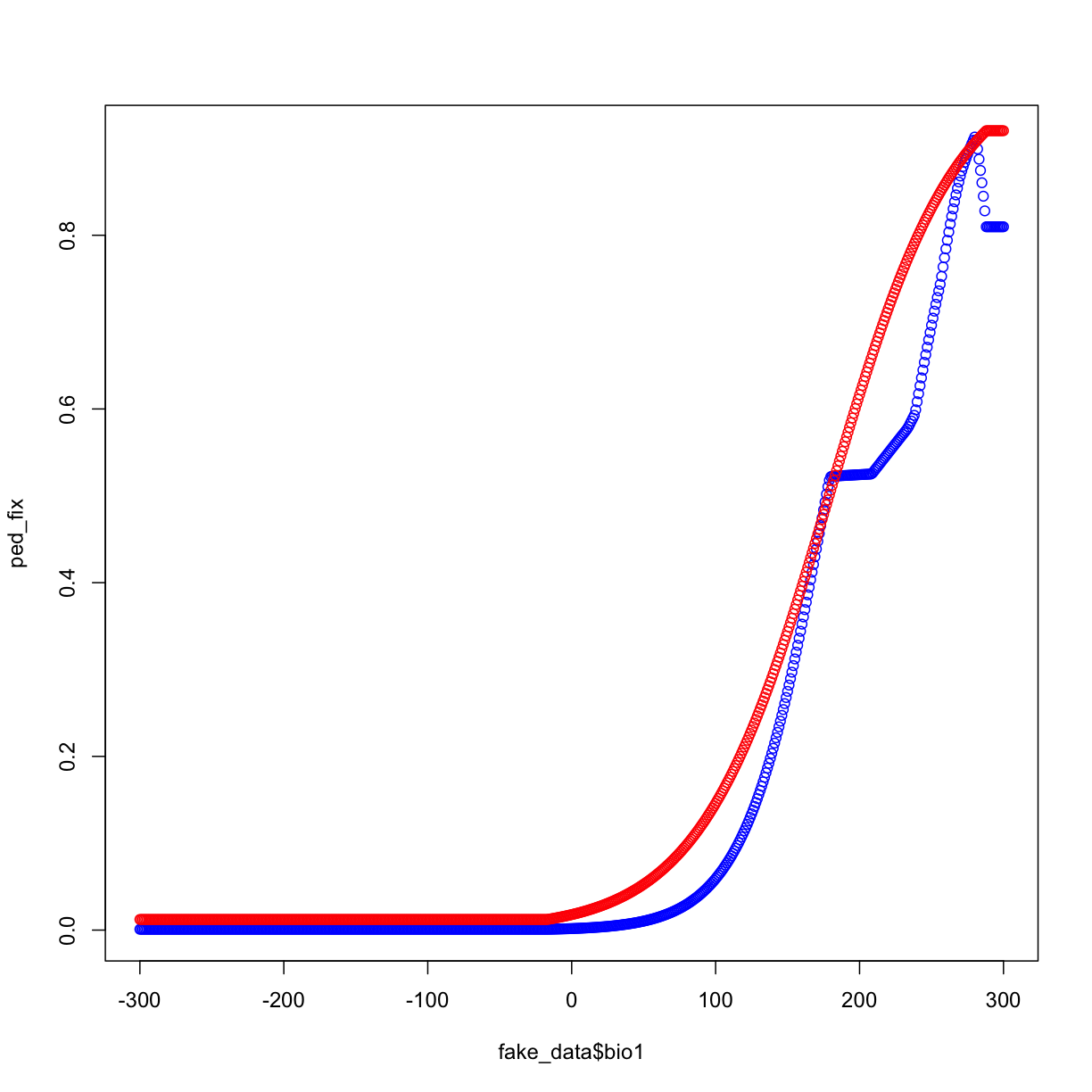
We can also set different beta-multiplers for different features.
` beta_threshold= 1
beta_categorical=1
beta_lqp=1
beta_hinge=1`
myparameters4 <- prepPara(userfeatures="LQH",## include L, Q, H features
beta_lqp=1.5, ## use different beta-multiplier for different features
beta_hinge=0.5 )
mod2_complex <- maxent(x=myPredictors[c("bio1","bio4","bio11")],
p=myResponse,
path=paste0(getwd(),"/output/maxent_outputs2_complex"),
args=myparameters4)
# you can also change others
6.3 Specify projection layers
Earlier we created a model, and then created a prediction from that model, but here we want to train the model and create a prediction simultaneously (like what happens in Maxent user interface).
myparameters5 <- prepPara(userfeatures="LQ",
betamultiplier=1,
projectionlayers=paste0(getwd(),"/data/bioclim")
)
# note:
# (1) the projection layers must exist in the hard disk (as relative to computer RAM);
# (2) the names of the layers (excluding the name extension) must match the names of the predictor variables.
# Create Model
mod3 <- maxent(x=myPredictors[c("bio1","bio4","bio11")],
p=myResponse,
path=paste0(getwd(),"/output/maxent_outputs3_prj1"),
args=myparameters5 )
# load the projected map
ped <- raster(paste0(getwd(),"/output/maxent_outputs3_prj1/species_bioclim.asc"))
plot(ped)
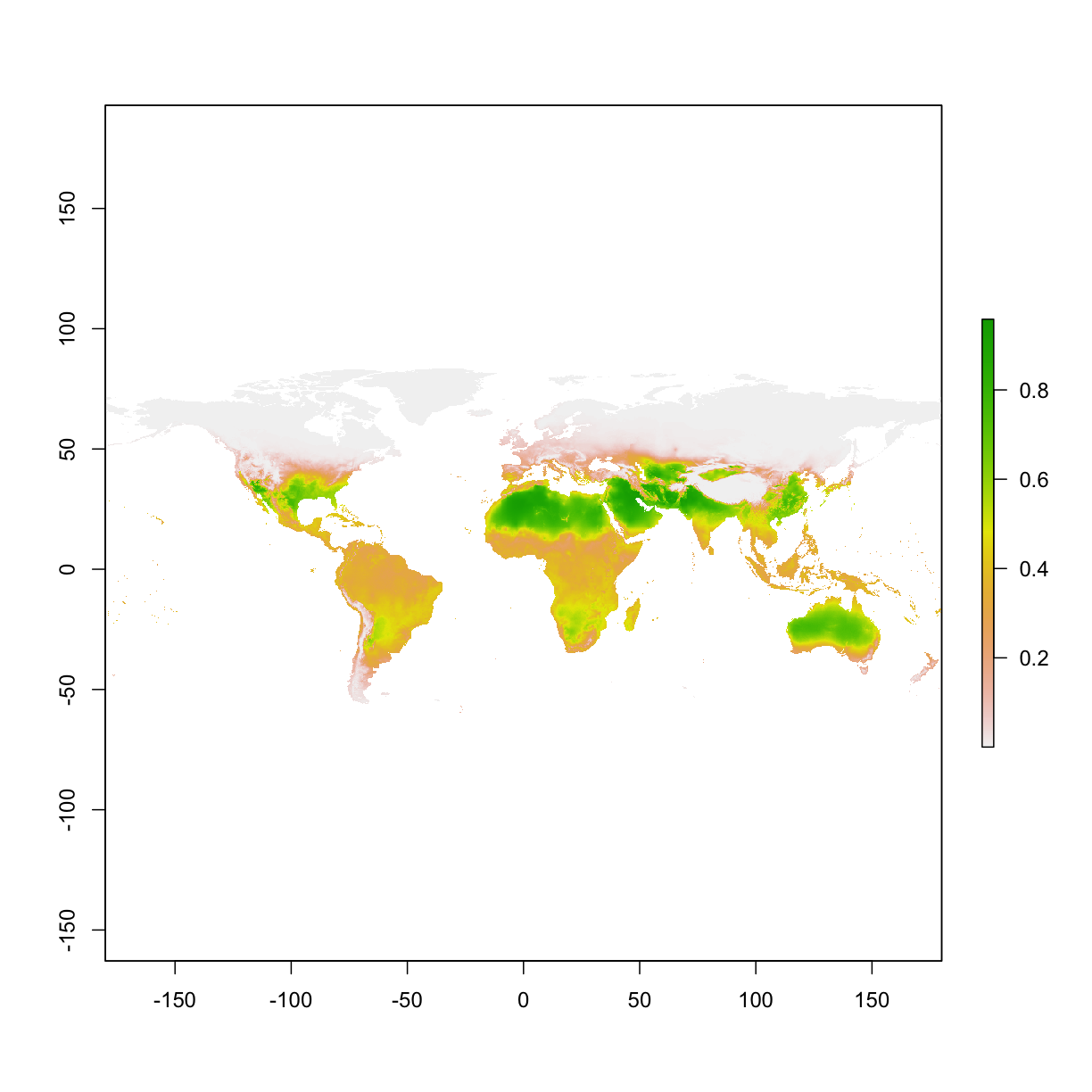
small experiment:
use different betamultiplier to get distributions
myparameters_relax <- prepPara(userfeatures="LQ",
betamultiplier=10,
projectionlayers=paste0(getwd(),"/data/bioclim")
)
myparameters5_default <- prepPara(userfeatures="LQ",
betamultiplier=1,
projectionlayers=paste0(getwd(),"/data/bioclim")
)
mod_relax <- maxent(x=myPredictors[c("bio1","bio4","bio11")],
p=myResponse,
path=paste0(getwd(),"/output/maxent_outputs3_prj_default"),
args=myparameters_relax )
mod_default <- maxent(x=myPredictors[c("bio1","bio4","bio11")],
p=myResponse,
path=paste0(getwd(),"/output/maxent_outputs3_prj_relax"),
args=myparameters5_default )
# load the projected map
ped_default <- raster(paste0(getwd(),"/output/maxent_outputs3_prj_default/species_bioclim.asc"))
ped_relax <- raster(paste0(getwd(),"/output/maxent_outputs3_prj_relax/species_bioclim.asc"))
plot(stack(ped_default,ped_relax))
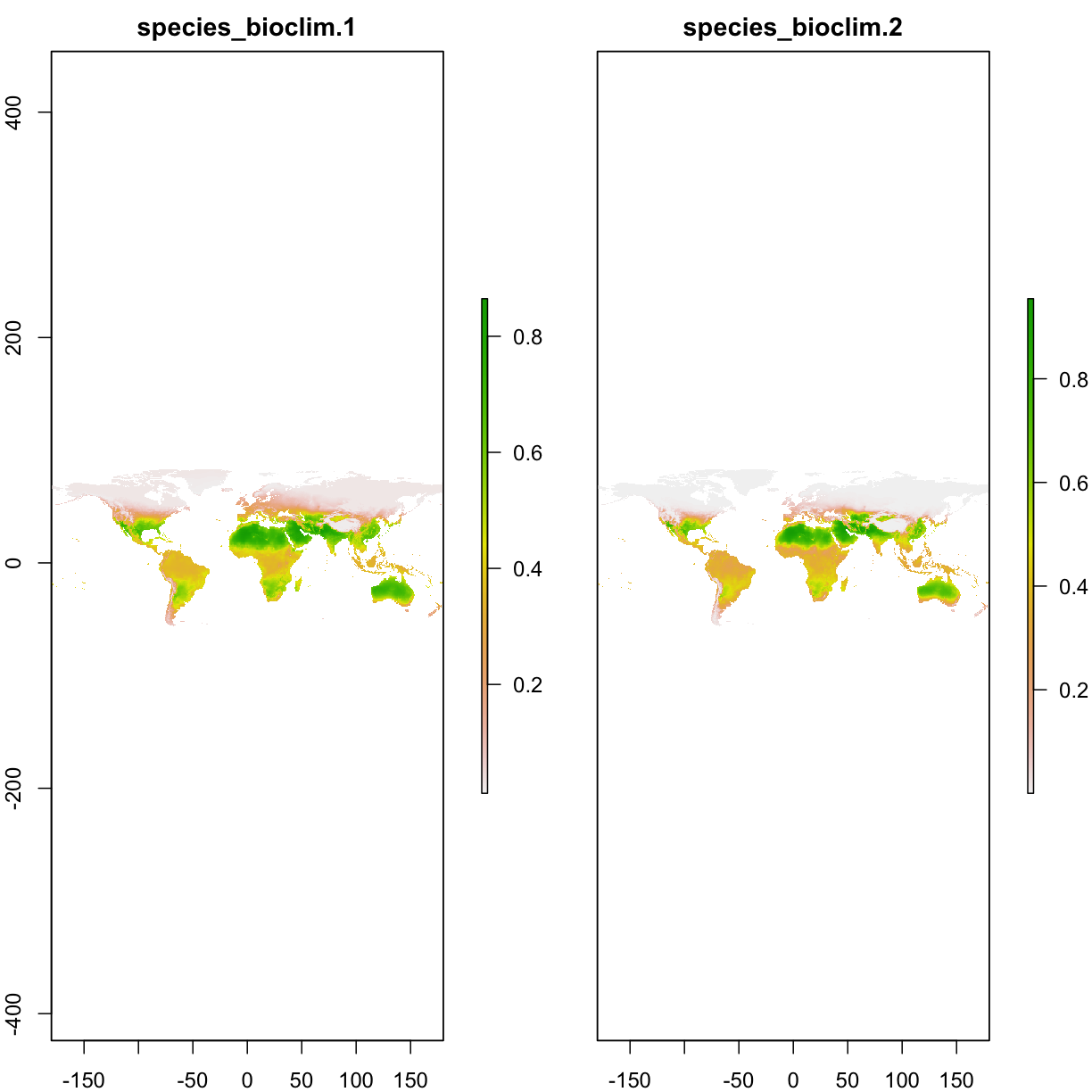
6.4 Clamping function
When we project across space and time, we can come across conditions that are outside the range represented by the training data. Thus, we can clamp the response so that the model does not try to extapolate to these “extreme” conditions.
The response curve can vary, with turning on or off clamping.
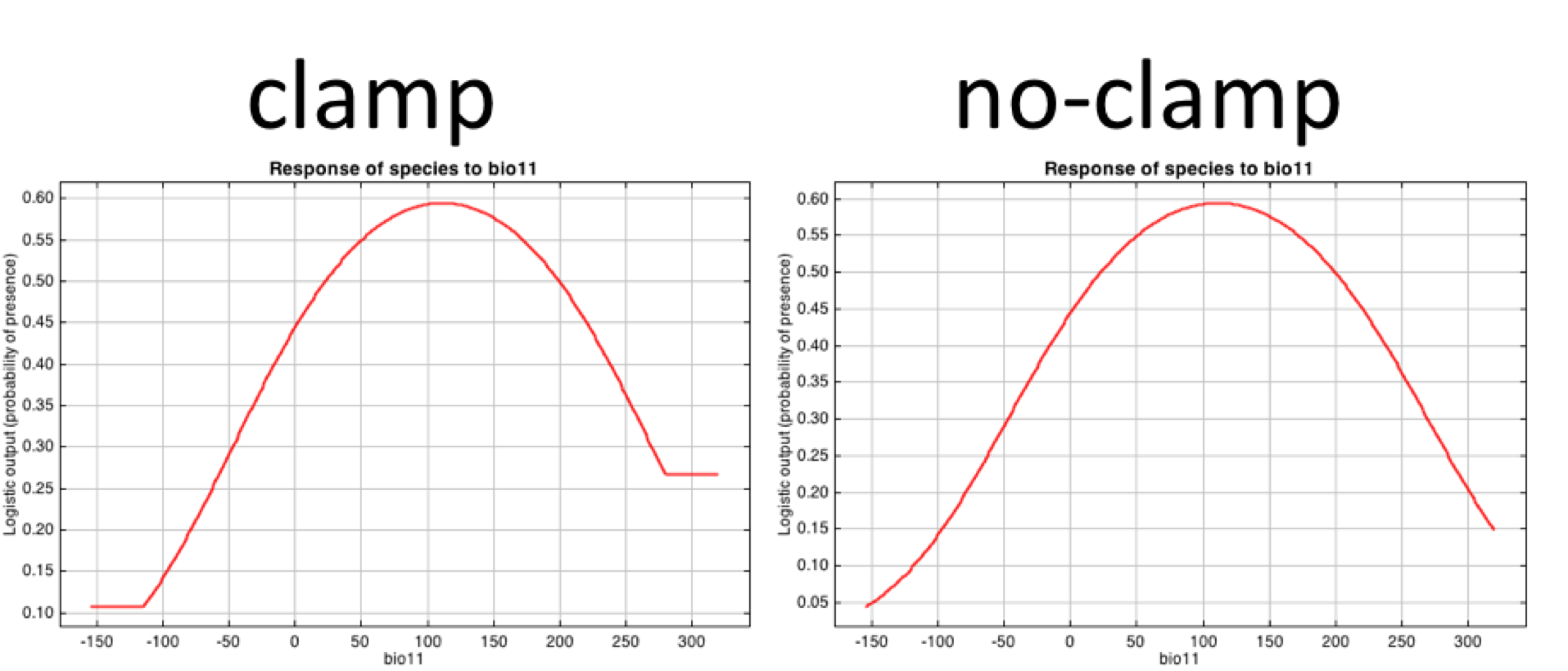 .
.
# enable or disable clamping function; note that clamping function is involved when projecting. Turning the clamping function on, gives the response value associated with the marginal value at the edge of the data
myparameters_clamp <- prepPara(userfeatures="LQ",
betamultiplier=1,
projectionlayers=paste0(getwd(),"/data/bioclim"),
doclamp = TRUE
)
mod_clamp <- maxent(x=myPredictors[c("bio1","bio11")],
p=myResponse,
path=paste0(getwd(),"/output/maxent_outputs4_clamp"),
args=myparameters_clamp )
myparameters_NOclamp <- prepPara(userfeatures="LQ",
betamultiplier=1,
projectionlayers=paste0(getwd(),"/data/bioclim"),
doclamp = FALSE
)
mod_NOclamp <- maxent(x=myPredictors[c("bio1","bio11")],
p=myResponse,
path=paste0(getwd(),"/output/maxent_outputs4_NOclamp"),
args=myparameters_NOclamp )
# Load the the two preditions and compare
ped_clamp <- raster(paste0(getwd(),"/output/maxent_outputs4_clamp/species_bioclim.asc") )
ped_noclamp <- raster(paste0(getwd(),"/output/maxent_outputs4_noclamp/species_bioclim.asc") )
plot(ped_clamp - ped_noclamp) # we may notice small differences, especially clamp shows higher predictions in most areas.
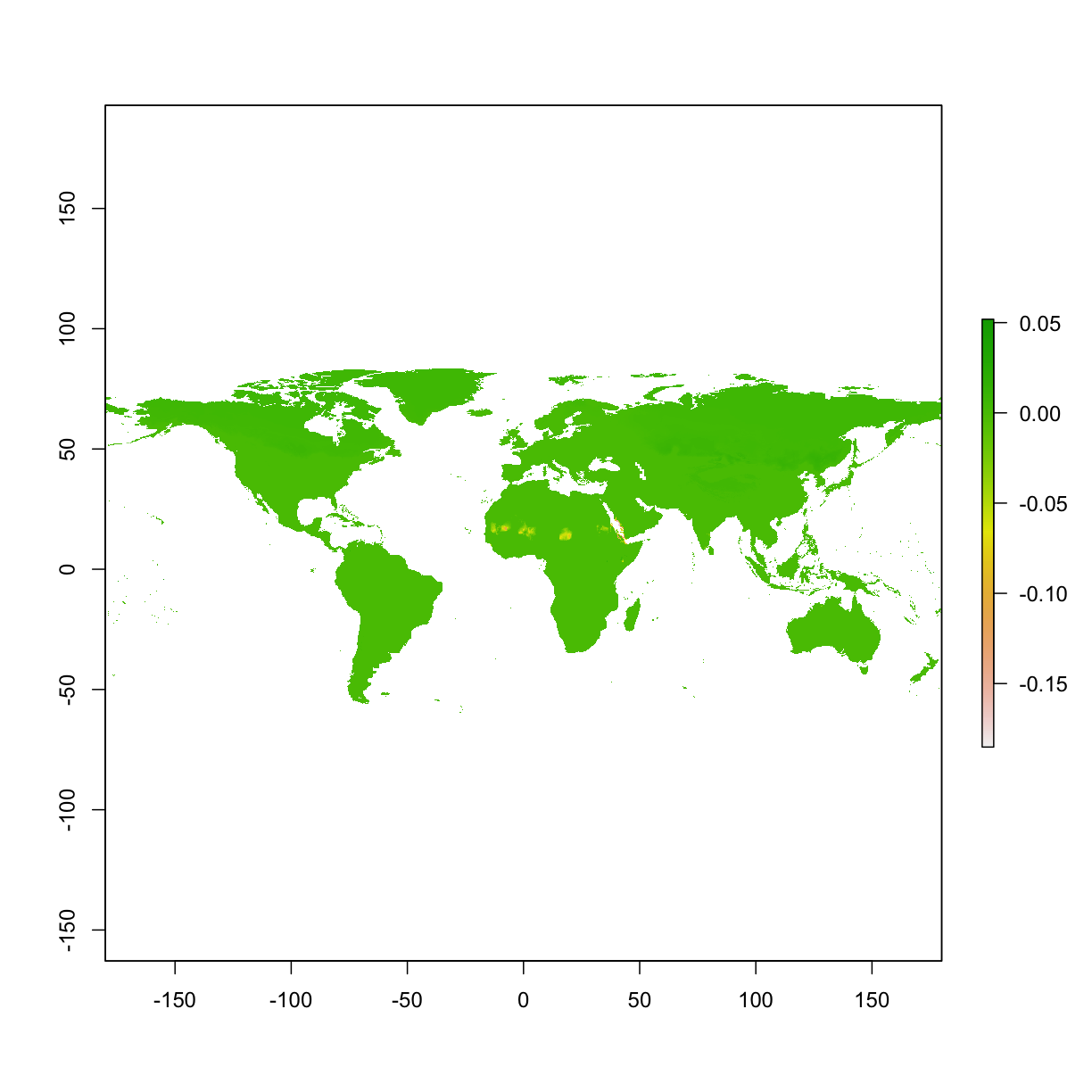
6.5 Do an experiment of “high AUC” model
Here we simulate two size of training areas (large vs. small)
occ_buffer <- buffer(occ_final,width=4*10^5) #unit is meter
clim_mask <- mask(clim, occ_buffer)
set.seed(1)
bg_small <- sampleRandom(x=clim_mask,
size=1000,
na.rm=T, #removes the 'Not Applicable' points
sp=T) # return spatial points
set.seed(1)
bg_big <- sampleRandom(x=clim,
size=1000,
na.rm=T, #removes the 'Not Applicable' points
sp=T) # return spatial points
plot(clim[[1]])
points(bg_big,col="black",cex=0.5)
points(bg_small,col="red",cex=0.5)
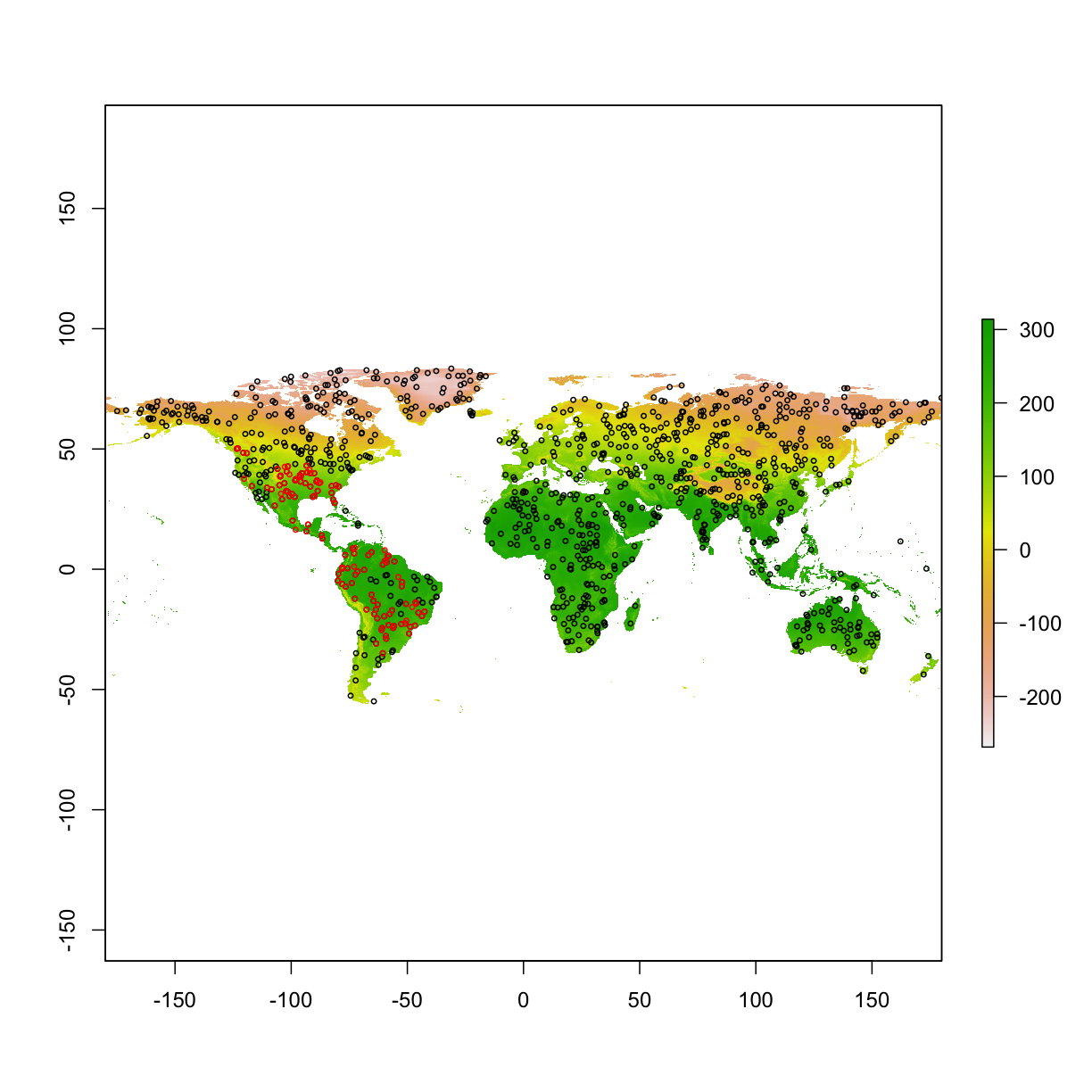
# extracting env conditions
env_occ_train <- extract(clim,occ_train)
env_occ_test <- extract(clim,occ_test)
# extracting env conditions for background
env_bg_small <- extract(clim,bg_small)
env_bg_big <- extract(clim,bg_big )
# prepare data frame for maxent
myPredictors_small <- data.frame(rbind(env_occ_train,env_bg_small))
myPredictors_big <- data.frame(rbind(env_occ_train,env_bg_big ))
myResponse_small <- c(rep(1,nrow(env_occ_train)),
rep(0,nrow(env_bg_small)))
myResponse_big <- c(rep(1,nrow(env_occ_train)),
rep(0,nrow(env_bg_big)))
# set up the parameters
myparameters <- prepPara(userfeatures="LQ",
betamultiplier=1,
projectionlayers=paste0(getwd(),"/data/bioclim")
)
# do the models
mod_small <- maxent(x=myPredictors_small[c("bio1","bio11")],
p=myResponse_small,
path=paste0(getwd(),"/output/maxent_outputs5_small"),
args=myparameters)
mod_big <- maxent(x=myPredictors_big[c("bio1","bio11")],
p=myResponse_big,
path=paste0(getwd(),"/output/maxent_outputs5_big"),
args=myparameters)
# show the diff of small/big model
ped_small <- raster(paste0(getwd(),"/output/maxent_outputs5_small/species_bioclim.asc"))
ped_big <- raster(paste0(getwd(),"/output/maxent_outputs5_big/species_bioclim.asc"))
ped_diff <- ped_small-ped_big
ped_combined <- stack(ped_small,ped_big,ped_diff)
ped_combined <- crop(ped_combined,extent(-150,-30,-60,60))
names(ped_combined) <- c("small_trainingArea","big_trainArea","difference")
plot( ped_combined )
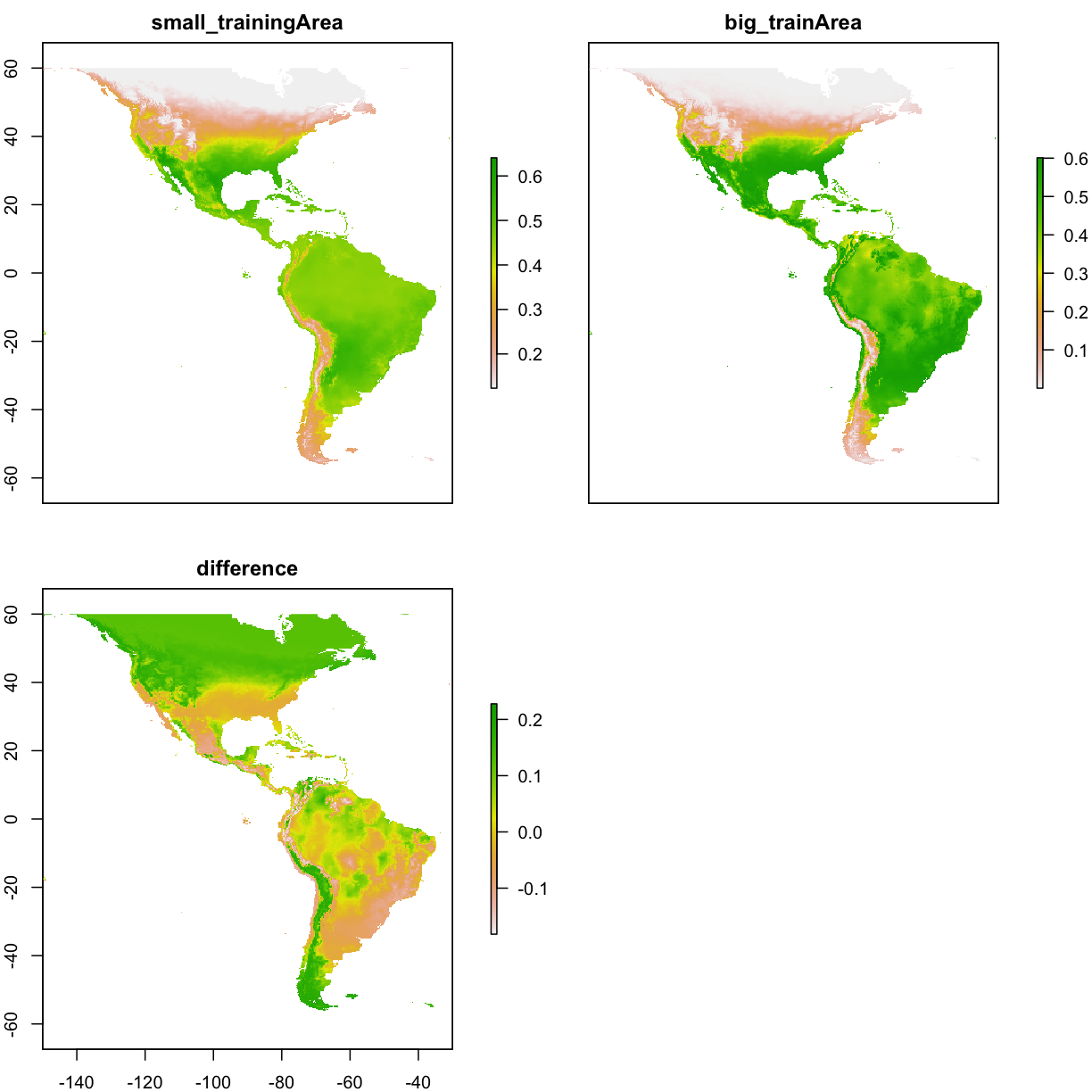
# compare the AUC , extract test occ data,
mod_eval_small <- dismo::evaluate(p=env_occ_test,a=env_bg_small,model=mod_small)
mod_eval_big <- dismo::evaluate(p=env_occ_test,a=env_bg_big, model=mod_big)
cat("AUC of small training area is: ",mod_eval_small@auc )
AUC of small training area is: 0.7183597
cat("AUC of big training area is: ",mod_eval_big@auc )
AUC of big training area is: 0.8201546
Challenge: train two maxent models with different parameters, and compare the predictions
–load occurrences & raster layers
–build axxx meterbuffer around occurrences
–maskraster by the buffer of occurrences
–generate random samples from the masked raster usingsampleRandom()
–extract()environmental conditions from raster by points
–re-format the environmental conditions as input for maxent
–train amaxentmodel with different paremeters
–usedevtools::source_url()to loadprepPara()function
–useprepPara()function to set different features or beta-multiplier
–useprepPara()function to set projection layers
–evaluate()the model with testing environmental conditionsSolution
library("raster") library("dismo") # prepare spatial occ data if(!file.exists("data/occ_raw.rdata")){ occ_raw <- gbif(genus="Dasypus",species="novemcinctus",download=TRUE) save(occ_raw,file = "data/occ_raw.rdata") }else{ load("data/occ_raw.rdata") } occ_clean <- subset(occ_raw,(!is.na(lat))&(!is.na(lon))) occ_unique <- occ_clean[!duplicated( occ_clean[c("lat","lon")] ),] occ_unique_specimen <- subset(occ_unique, basisOfRecord=="PRESERVED_SPECIMEN") occ_final <- subset(occ_unique_specimen, year>=1950 & year <=2000) coordinates(occ_final) <- ~ lon + lat myCRS1 <- CRS("+init=epsg:4326") # WGS 84 crs(occ_final) <- myCRS1 # prepare raster data if( !file.exists( paste0("data/bioclim/bio_10m_bil.zip") )){ utils::download.file(url="http://biogeo.ucdavis.edu/data/climate/worldclim/1_4/grid/cur/bio_10m_bil.zip", destfile="data/bioclim/bio_10m_bil.zip" ) utils::unzip("data/bioclim/bio_10m_bil.zip",exdir="data/bioclim") } # load rasters clim_list <- list.files("data/bioclim/",pattern=".bil$",full.names = T) clim <- raster::stack(clim_list) occ_buffer <- buffer(occ_final,width=4*10^5) #unit is meter clim_mask <- mask(clim, occ_buffer) # extract environmental conditions set.seed(1) bg <- sampleRandom(x=clim_mask, size=10000, na.rm=T, #removes the 'Not Applicable' points sp=T) # return spatial points set.seed(1) # randomly select 50% for training selected <- sample( 1:nrow(occ_final), nrow(occ_final)*0.5) occ_train <- occ_final[selected,] # this is the selection to be used for model training occ_test <- occ_final[-selected,] # this is the opposite of the selection which will be used for model testing # extracting env conditions env_occ_train <- extract(clim,occ_train) env_occ_test <- extract(clim,occ_test) # extracting env conditions for background env_bg <- extract(clim,bg) #combine the conditions by row myPredictors <- rbind(env_occ_train,env_bg) # change matrix to dataframe myPredictors <- as.data.frame(myPredictors) # repeat the number 1 as many times as the number of rows in p, and repeat 0 for the rows of background points myResponse <- c(rep(1,nrow(env_occ_train)), rep(0,nrow(env_bg))) if(!require(devtools)){ install.packages("devtools") } devtools::source_url("https://raw.githubusercontent.com/shandongfx/nimbios_enm/master/Appendix2_prepPara.R") # training a maxent model with parameters myparameters1 <- prepPara(userfeatures="LQ", betamultiplier=0.01, projectionlayers=paste0(getwd(),"/data/bioclim") ) mymodel1 <- maxent(x=myPredictors[c("bio1","bio4","bio11")], p=myResponse, path=paste0(getwd(),"/output/maxent_homework1"), args=myparameters1 ) myparameters2 <- prepPara(userfeatures="LQ", betamultiplier=1000) mymodel2 <- maxent(x=myPredictors[c("bio1","bio4","bio11")], p=myResponse, path=paste0(getwd(),"/output/maxent_homework2"), args=myparameters2 ) # evaluate model based on testing data mod_eval1 <- dismo::evaluate(p=env_occ_test, a=env_bg, model=mymodel1) mod_eval2 <- dismo::evaluate(p=env_occ_test, a=env_bg, model=mymodel2) mod_eval1@auc mod_eval2@auc